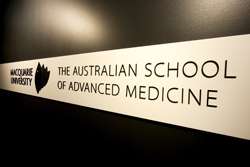Musculoskeletal training could help millions

(Medical Xpress) -- Many Australians are suffering from pain related to treatable musculoskeletal conditions. These can be difficult for primary care doctors to diagnose without further postgraduate training.
An RACGP survey estimates six million people across the country suffer from musculoskeletal problems costing the health system and economy many millions of dollars every year. Many of these people have soft tissue pain sources that are not always identified, in their joints, muscles and ligaments.
“Soft tissue pain is a great mimic,” says Macquarie University’s Associate Professor Michael Creswick. “These disorders can mimic many other health problems and yet are diagnosable and quite often very treatable if doctors are appropriately trained. Early intervention can minimise chronic pain and long term medication such as anti-inflammatories and opioids.”
Creswick and Associate Professor Rod Ayscough have helped establish the country’s only Master of Medicine Degree in Musculoskeletal Medicine at Macquarie University’s Australian School of Advanced Medicine. The course specifically trains qualified GPs to better identify and treat musculoskeletal disorders. Such training is also growing in the United States and Europe as more is understood about musculoskeletal conditions.
Creswick believes that doctors, after ruling out serious causes of pain, often refer patients to therapists for treatment of soft tissue pain without a specific diagnosis. This is because the source of pain is not always apparent from the application of a standard medical approach.
“Our course participants are trained in recognising pain referral patterns, performing a detailed physical examination and applying advanced physical medicine treatment skills. These include gentle manual therapy, the injection of muscular “trigger points” if clinically indicated and specific exercise prescription.
“There has been a worldwide medical trend towards treating pain as an entity in itself, and to diagnose persisting pain as intractable, due to nerve damage. However some people who have been told they have “neuropathic” pain have been found to have ongoing unrecognised but treatable musculoskeletal, soft tissue disorders, without nerve damage,” Creswick says.
Ayscough and Creswick train GPs to look for possible sources of pain from soft tissues, including muscles, ligaments, the bony attachment points of muscles, as well as associated nerves. “How these structures interact in relation to each patient’s posture and movement is an important part of diagnosis and treatment.”
“GPs already have an excellent overview of the whole patient and knowledge of underlying serious diseases. We use a medical model of diagnosis, so we only train experienced GPs. Often, with further training at ASAM, known pain patterns will be evident on examination, and our graduates can immediately treat a musculoskeletal problem. If the patient responds and stays pain-free, then they can avoid expensive and sometimes unnecessary tests. One of the great advantages of primary care is the ability of the doctor to treat patients and observe progress over short timeframes, and adjust management based on those observations. If a patient doesn’t respond as expected, a revised diagnosis may be apparent, or it may be appropriate to order radiological imaging or blood tests to aid diagnosis,” says Creswick.
“Many patients have muscular and postural patterns that are leading to their pain, and that’s what we train our graduates to identify and treat.”















